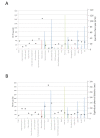Comparative toxicity of 24 manufactured nanoparticles in human alveolar epithelial and macrophage cell lines
- PMID: 19405955
- PMCID: PMC2685765
- DOI: 10.1186/1743-8977-6-14
Comparative toxicity of 24 manufactured nanoparticles in human alveolar epithelial and macrophage cell lines
Abstract
Background: A critical issue with nanomaterials is the clear understanding of their potential toxicity. We evaluated the toxic effect of 24 nanoparticles of similar equivalent spherical diameter and various elemental compositions on 2 human pulmonary cell lines: A549 and THP-1. A secondary aim was to elaborate a generic experimental set-up that would allow the rapid screening of cytotoxic effect of nanoparticles. We therefore compared 2 cytotoxicity assays (MTT and Neutral Red) and analyzed 2 time points (3 and 24 hours) for each cell type and nanoparticle. When possible, TC50 (Toxic Concentration 50 i.e. nanoparticle concentration inducing 50% cell mortality) was calculated.
Results: The use of MTT assay on THP-1 cells exposed for 24 hours appears to be the most sensitive experimental design to assess the cytotoxic effect of one nanoparticle. With this experimental set-up, Copper- and Zinc-based nanoparticles appear to be the most toxic. Titania, Alumina, Ceria and Zirconia-based nanoparticles show moderate toxicity, and no toxicity was observed for Tungsten Carbide. No correlation between cytotoxicity and equivalent spherical diameter or specific surface area was found.
Conclusion: Our study clearly highlights the difference of sensitivity between cell types and cytotoxicity assays that has to be carefully taken into account when assessing nanoparticles toxicity.
Figures



Similar articles
-
Assessing toxicity of fine and nanoparticles: comparing in vitro measurements to in vivo pulmonary toxicity profiles.Toxicol Sci. 2007 May;97(1):163-80. doi: 10.1093/toxsci/kfm018. Epub 2007 Feb 14. Toxicol Sci. 2007. PMID: 17301066
-
Toxicity of tungsten carbide and cobalt-doped tungsten carbide nanoparticles in mammalian cells in vitro.Environ Health Perspect. 2009 Apr;117(4):530-6. doi: 10.1289/ehp.0800121. Epub 2008 Dec 1. Environ Health Perspect. 2009. PMID: 19440490 Free PMC article.
-
Toxicity of 11 Metal Oxide Nanoparticles to Three Mammalian Cell Types In Vitro.Curr Top Med Chem. 2015;15(18):1914-29. doi: 10.2174/1568026615666150506150109. Curr Top Med Chem. 2015. PMID: 25961521
-
Understanding Nanoparticle Toxicity Mechanisms To Inform Redesign Strategies To Reduce Environmental Impact.Acc Chem Res. 2019 Jun 18;52(6):1632-1642. doi: 10.1021/acs.accounts.9b00053. Epub 2019 Jun 3. Acc Chem Res. 2019. PMID: 31181913 Review.
-
Inhalation toxicity assessment of carbon-based nanoparticles.Acc Chem Res. 2013 Mar 19;46(3):770-81. doi: 10.1021/ar200311b. Epub 2012 May 11. Acc Chem Res. 2013. PMID: 22574947 Review.
Cited by
-
Functionalized polystyrene nanoparticles as a platform for studying bio-nano interactions.Beilstein J Nanotechnol. 2014 Dec 15;5:2403-12. doi: 10.3762/bjnano.5.250. eCollection 2014. Beilstein J Nanotechnol. 2014. PMID: 25671136 Free PMC article. Review.
-
Immune response and innervation signatures in aseptic hip implant loosening.J Transl Med. 2016 Jul 7;14(1):205. doi: 10.1186/s12967-016-0950-5. J Transl Med. 2016. PMID: 27387445 Free PMC article.
-
Preparation of cells for assessing ultrastructural localization of nanoparticles with transmission electron microscopy.Nat Protoc. 2010 Apr;5(4):744-57. doi: 10.1038/nprot.2010.2. Epub 2010 Mar 25. Nat Protoc. 2010. PMID: 20360769
-
The toxicity and therapeutic effects of single-and multi-wall carbon nanotubes on mice breast cancer.Sci Rep. 2018 May 30;8(1):8375. doi: 10.1038/s41598-018-26790-x. Sci Rep. 2018. Retraction in: Sci Rep. 2023 Nov 15;13(1):19953. doi: 10.1038/s41598-023-46596-w. PMID: 29849103 Free PMC article. Retracted.
-
Evaluation of cytotoxic, genotoxic and inflammatory responses of nanoparticles from photocopiers in three human cell lines.Part Fibre Toxicol. 2013 Aug 22;10:42. doi: 10.1186/1743-8977-10-42. Part Fibre Toxicol. 2013. PMID: 23968360 Free PMC article.
References
LinkOut - more resources
Full Text Sources
Other Literature Sources

